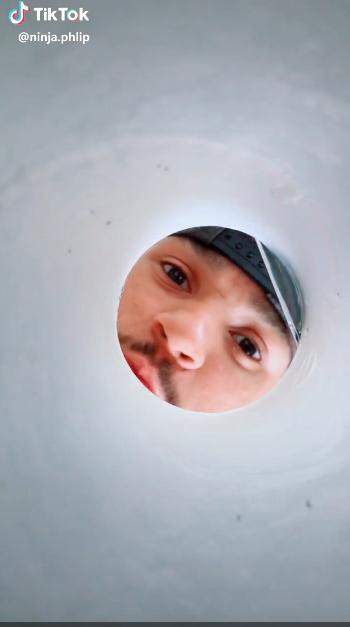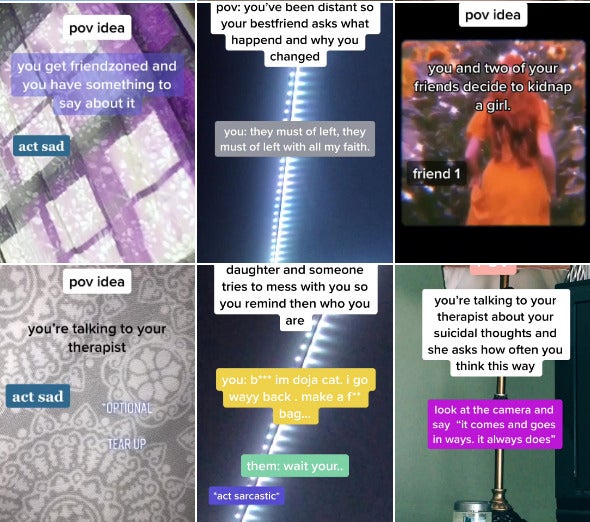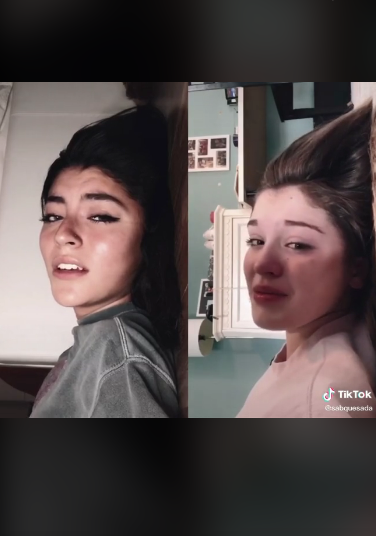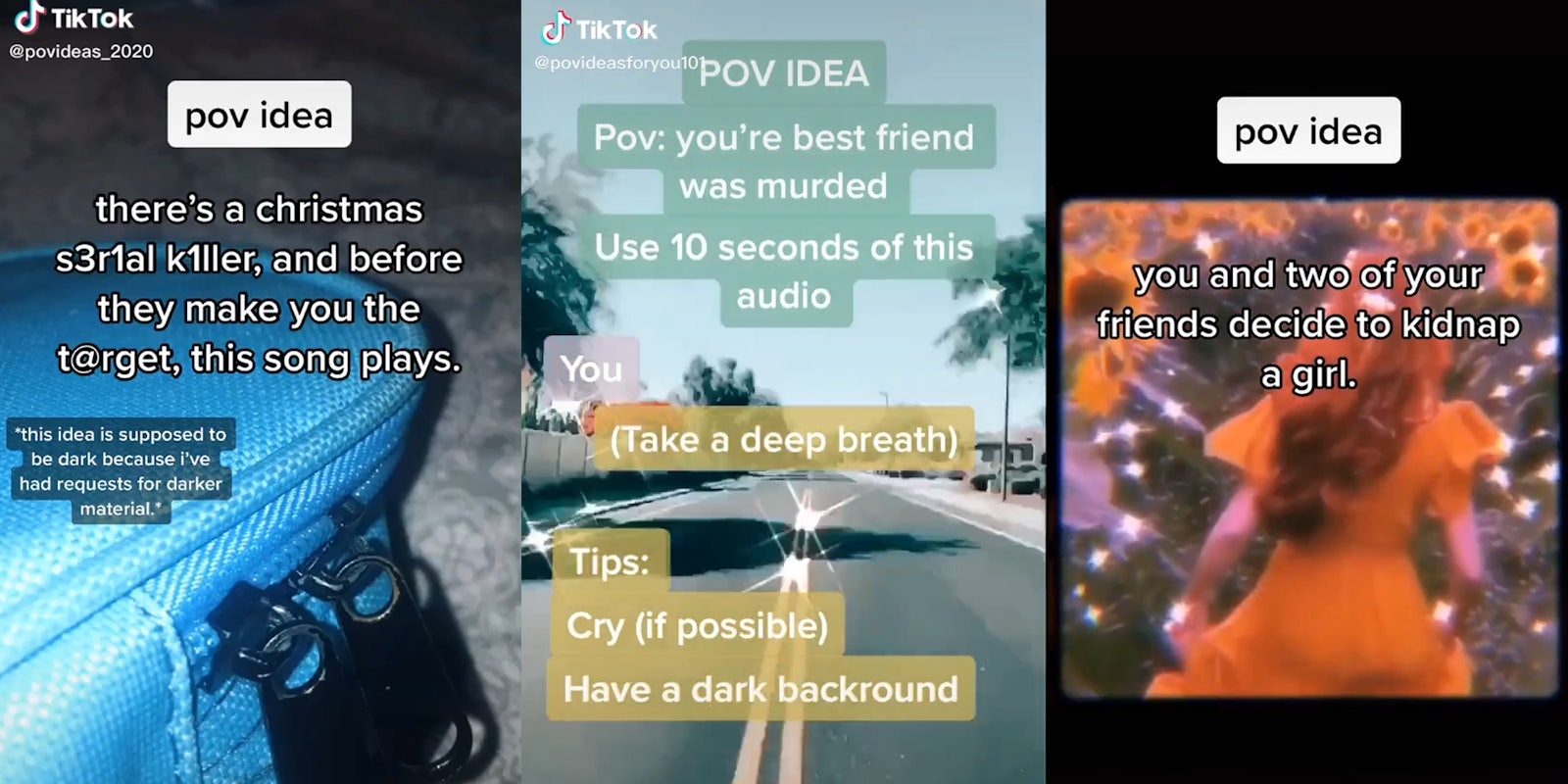“Welcome to heaven, darling!”
The young woman is wearing a black and white tank top, hair pulled back. There are grayish orange smudges on her face and chest. After some small talk with this new arrival—you, ostensibly, since this is a TikTok POV video—she reveals why she’s there: “One of the planes crashed into my building and I didn’t make it out on time.” The caption of the video reads: “ur in heaven and u meet someone that died in 9/11.”
It’s a jarring video, tonally dissonant in its casualness. There are a lot of other young people roleplaying those who died on 9/11 on TikTok. The point of view (POV) genre, in which someone appears to either be addressing the viewer directly or providing an alternate perspective, is massively popular: There are personalities known for POVs, and accounts devoted to “ideas” for them. The #pov tag has more than 128 billion views.
Just last year, POVs were approached like any other TikTok challenge. “What my beauty blender sees when I’m in a hurry,” goes one popular 2019 video; another shows the POV of the bottom of a Pringles can as a man hungrily tries to reach the bottom. Those humorous, lighthearted POVs still exist, and there are certainly some theater-kid vibes within the genre, something more broadly called out in a recent Onion headline.

But perspectives have gotten a little darker over the last year, as TikTok has grown. It faced a major moderation challenge this week: removing videos of 33-year-old Ronnie McNutt’s suicide, which originated on Facebook. Though many people reported the video, it still spread quickly on the app, at times hidden inside innocent-looking videos to scare people. But you could just as easily scroll across a POV of a young woman with a fake gunshot wound on her forehead, part of a macabre trend about museums where you can see how people died.
Earlier this year, users created POVs depicting abusive relationships, though one participant told the Daily Dot it was to raise “awareness” around the issue of domestic abuse. In May, users were called out for doing POVs of abusive exes. Last month, users saw backlash for doing POVs of people who died in the Holocaust, though many of the videos were already a couple of months old or had been removed or made private by the users. Many of the participants wore makeup that made their faces look bloodied, bruised, or gaunt. A 15-year-old who participated in the trend told Wired she was trying to “spread awareness.”
While many of these questionable videos don’t appear to have violated TikTok’s community guidelines, the #holocaustchallenge tag some of the videos were associated with has been blocked. Asked about how these kinds of videos are moderated, a TikTok spokesperson said, “We are committed to promoting a safe and positive app environment for our users,” and directed us to its guidelines. They detail multiple scenarios that could result in removed content under its “dangerous individuals or organizations” list, including depicting hate groups or kidnapping. But it makes an exception for “Educational, historical, satirical, artistic, and other content that can be clearly identified as counterspeech or aims to raise awareness of the harm caused by dangerous individuals and/or organizations.”
The “raise awareness” clause makes it more difficult to moderate some POVs, or discern their intent. In July, musician Absofacto asked creators using his song “Dissolve” in a POV trend to stop, after survivors of abuse contacted him. Some videos in the trend depict young people pretending to be moms or dads and speaking to their “child” in a disturbing way. It wasn’t raising awareness, and several creators removed their videos after Absofacto spoke out, but there are still multiple compilations of the trend on YouTube, including a series titled “family tiktok POVs that gave me baby fever.”
Multiple accounts exist specifically for POV ideas, either to generate them or perform them. Several POV accounts, like povhypehouse21, riff on the collab houses of TikTok, and state whether they’re open or closed for “auditions.”

Brie, who runs a POV idea account, says those “auditions” are more a mark of exclusivity for some accounts. She started her account as a “joke,” but got more serious as she gained views and followers. Her POVs are presented as prompts for videos, and are more emotion-driven: “a friend notices you’re acting off, so they ask you what’s wrong.” Other POV accounts present similar scenarios involving friends or family, with stage directions like “cry” or “look stunned.” One popular video from eviespovideas prompts: “Your kidnapper wants to take a photo to send to your family.” There are certainly some Wattpad vibes here.
“Personally, I think POV accounts are so popular because they portray emotions that seem cinematic,” Brie tells the Daily Dot, “and it’s an amazing experience not only for the creator, but for the audience as well.”

But “cinematic” is open to interpretation on TikTok. There are multiple videos of girls lying on the ground after an imaginary school shooting, acting out their last moments. One video shows a victim of the 1999 Columbine shooting greeting someone in heaven.
For younger users, many not even born in 2001, or 1999, this could be an alternate way to channel an experience, even if it’s not a lived one. Sept. 11 and school shootings have followed, and numbed, a generation of kids.
“I think the accounts that do the more extreme povs are brave for what they’re doing,” says Brie, “especially considering that they could get backlash from people who think what they’re doing is insensitive.”
What seems to be the structural issue is that TikTok’s format doesn’t exactly allow for elaboration or historical context or nuance. And so POVs are a one-sided performance, creators making up their own context and dialogue for entertainment. If they’re raising awareness, it’s more fundamentally, and essentially, for themselves.
More on TikTok
| Everything you need to know to get started on TikTok |
| A slowed-down song and a slow zoom trend collide on TikTok |
| People have questions about this TikToker’s skull collection |
| Sign up to receive the best of the internet in your inbox. |


